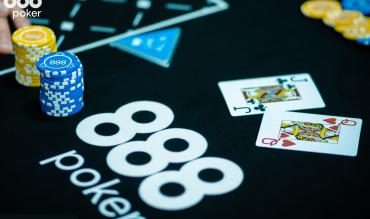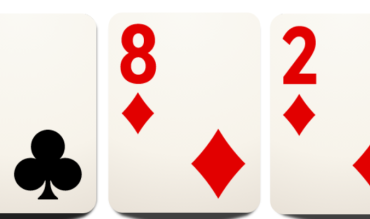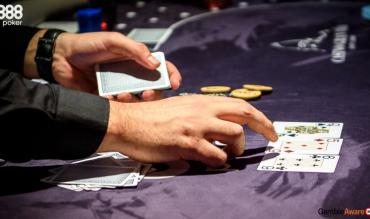Updated on April 14, 2025
You’ll hear two kinds of players using the word ‘blockers’ at the poker tables: Good players and those trying to sound like good players.
You shouldn’t confuse wat is a blocker bet in poker with what is a blocker in poker.
- A blocker is a card you hold that prevents or reduces the likelihood of your opponent having a specific hand.
- A blocker bet is typically a small bet designed to get you to a showdown cheaply.
This article explains the basic premise of blockers in poker to ensure you're in camp one.
We’ll teach you how to begin using blockers to make better decisions in poker games.
What Is a Blocker in Poker?
If you’ve asked, ‘What is a blocking bet in poker?’ you might think you know about blockers already, but the concept we’ll consider today is entirely different.
A blocker is a card that allows you to make logical deductions about your opponent's holdings. The process is like trying to construct an opponent's range, but we're not using assumptions when we talk about blockers.
To classify a card as a blocker, we must know exactly where it is. No guesswork allowed!
Usually, players will reference their poker hand when discussing blockers, but community cards and any accidentally exposed cards can also be blockers.

The idea behind blockers is pretty straightforward:
This knowledge prevents them from having certain holdings. That reasoning might sound obvious, but knowing how to use this information to your advantage isn’t as clear-cut.
To understand blockers properly, you need to know how poker combos work, so let’s take a quick look. This information might get a little confusing, but it'll be worth it—even if only to impress your friends with the word 'combinatorics' at parties!
History of Blockers in Poker
Simple blocker theory has existed for a long time, but the ideas have become more widespread over the last few decades. This development is due to increased computer power and groundbreaking books like Bill Chen's The Mathematics of Poker.
Players now take a more mathematical GTO poker approach to the game, making blockers a 'must-know' for anyone looking to play well.
Poker Combinatorics
A deck contains 52 cards, which can be paired together to create 1,336 unique poker hands, such as A♠️A♦️, Q♥️9♥️, and A♣️K♠️.
Each of these is known as a combination or combo for short:
- There are four combos of each suited hand (6s7s, 6♥️7♥️, 6♣️7♣️, 6♦️7♦️)
- There are six of each pocket pair (A♥️A♦️, A♥️A♠️, A♥️A♣️, A♠️A♦️, A♠️A♣️ and A♦️A♣️)
- 12 of each unsuited hand (such as 6♠️7♦️, 6♥️7♠️ and 6♣️7♠️)
You might have heard people grouping pocket pairs, off-suit and suited hands together to say there are 169 different starting hands in poker.
However, we can't do this when working with blockers because, as you'll see shortly, each combination matters.
How Blockers Work
Now that we know how poker hands are constructed, we can look at how blockers can affect things.
Pretend you’re holding A♥️7♠️ preflop and consider how your cards impact the likelihood that your opponent has 67s, 67o and AA (You’ll block way more hands than this in practice, but let’s keep things simple for now.)
Firstly, your 7♠️ prevents, or ‘blocks’ your opponent from having 6♠️7♠️, which leaves three remaining 67s combinations (hearts, clubs, and diamonds). The number of 67 off-suit combinations takes a hit, too, dropping to 9 from 12.

Your single seven of spades reduces the chance that your opponent has 67 by 25%.
Blockers in poker become even more powerful when considering pocket pairs. For example, with the Ace of Hearts, you block three of 6 the possible combinations of AA (A♥️A♦️, A♥️A♠️, A♥️A♣️). This calculation leaves just three more (A♠️A♦️, A♠️A♣️ and A♦️A♣️), which means that holding one ace reduces the possibility that your opponent has AA by a whopping 50%.
In fact, holding one ace reduces the chance that your opponent will also have one by 12.7%. This number is significant, so good players often use Ax hand to execute a poker bluff preflop.
It's not that they have an ace, but given their blocker, it's less likely that their opponent would have one, making their bluff more likely to succeed.
When you hold a pair, however, things can get even crazier. With 7♠️7♥️, for example, your opponent can only have two combinations of 67s, six combinations of 67o, and one combination of 77.
This scenario might not seem too significant, but this blocker effect can be decisive when you’re in a pickle at the tables.

For example, on a board of 4♣️5♣️8♦️2♦️K♥️, this blocking effect can often make 66 or 77 better hands to call with than bigger pairs like TT or JJ.
Getting into the habit of considering blockers also enables you to make more accurate reads about your opponent's range post-flop.
How Do Blockers Work Post-Flop?
Since you can use blockers on the board, things can get more intricate post-flop, but the general gist is similar.
- Let’s say our opponent check raises the river on Q♥️9♥️A♥️3♦️7♣️.
- Here they represent a flush, but the flopped A♥️ makes it impossible for him to have any of the A♥️X♥️ combinations in his hand.
- So, a flush is less likely since suited aces make up such a large proportion of a player’s flush range.
Similarly, the Q♥️ and 9♥️ block hands like KQh, JQh, QTh, 9Th, 89h, and K9h, which limits the number of flushes he can have further.

If you hold a hand like A♣️8♥️, you will also block hands like 68h, 78h, and T8h , which only leaves a handful of flush combinations in your opponent’s range. If they opened from early position, they may only have J♥️T♥️ and K♥️J♥️ as possible flushes in their odds of poker hands range.
Making a call is very tempting, weighed against all the different bluffs they might have, especially at lower stakes, where players don’t always think about their bluffs.
- If we compare this to a board of 2♥️5♥️6♥️J♣️Q♠️, however, we can see how much of an impact blockers have.
- If you hold A♣️Q♣️ on this board your opponent can now have all the Ace-high, broad-way and suited connector flushes, which makes their raise much more scary.
How Valuable Are My Blockers?
You shouldn’t use a blocker in poker as the only reason to make a specific play. However, there are situations where blockers can push you in a particular direction when things are close.
If you have the A♣️ on 3♣️5♣️6♣️J♦️K♦️, for example, you block the A-high flushes, which also allows you to represent them yourself. While this might seem like a great reason to fire a bluff, it can be a bad idea if you’re against a calling station or have an image as a bit of a maniac.
Like most things in poker, the true value of your blockers can vary depending on your opponent, but the general rule is quite simple:
The more significant your blockers are, the more you should let them sway a close decision.
Blocker in Poker: QUIZ – Scroll down for answers
Now you know all about blockers, here’s a true or false based quiz to see what you’ve learnt.
1: Blockers are based on known cards, not assumptions.
2: Community and exposed cards can also be blockers.
3: If you know where a card is, your opponent can’t have it
4: There are 169 unique poker hands.
5: Holding one ace reduces the chance your opponent has Pocket Aces by 50%.
6: Before learning about blockers, you should ask yourself, what is a blocker bet in poker?
7: All suited hands have FOUR combinations.
8: Blockers are useful in both preflop and postflop decision-making.
9: Blockers help but shouldn’t be the only reason to bluff.
10: Opponent tendencies and game flow can affect blocker value.
Blocker in Poker – QUIZ Answers
1: True
2: True
3: True (unless they expose it themselves)
4: False
5: True
6: False
7: True
8: True
9: True
10: True
See Also
Stud, Omaha, Hold’em, Bluffcatch, Bluff, Blocker bet, Range, Combination, Flush, Postflop, Board, Call, Fold, Raise, Action


